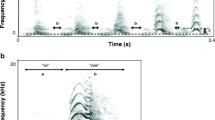Abstract
Male Balclutha incisa (Cicadellidae: Deltocephalinae) produces substrate-borne signals as well as sounds produced by wing fluttering. Males produce 6 signal types that are associated with different behavioral activities: (i) cleaning, (ii) calling, (iii) precopulatory, (iv) copulation, (v) postcopulatory behavior, and (vi) aggression. Within each category signals have a high degree of stereotypy in regard to their temporal structure. Females produce two kinds of signals: (i) a duetting signal in response to the male, and (ii) an introductory or preparatory signal before the main signal. The sexes duet, with the female placing its signal immediately after the first two components of the male’s call, with an interval of some 136 ms. We discuss the role of the male calls in attracting females and the importance of the duet in maintaining a temporary pair-bond.
Similar content being viewed by others
References
Alexander, R. D. (1967). Acoustic communication in Arthropods. Ann. Rev. Entomol. 12:449–526.
Bailey, W. J. (1991). Mate finding: selection on sensory cues. In Bailey, W. J., and Ridsdill-Smith, J. (eds.), Reproductive Behaviour of Insects, Chapman and Hall, London, pp. 42–74.
Bailey, W. J. (2003). Insect duets: Underlying mechanisms and their evolution. Physiol. Entomol. 28:157–174.
Bailey, W., and M. Nuhardiyati (in press). Copulation, the dynamics of sperm transfer and female refractoriness in the leafhopper Balclutha incisa (Matsumura) (Hemiptera: Cicadellidae: Deltocephalinae). Physiol. Entomol.
Bennet-Clark, H. C., and Young, D. (1992). A model of the mechanism of sound production in cicadas. J. Exp. Biol. 173:123–153.
Booij, C. J. H. (1982). Biosystematics of the Muellerianella complex (Homoptera, Delphacidae) interspecific and geographic variation in acoustic behaviour. Z. Tierpsychol. 58:31–52.
Claridge, M. F. (1983). Acoustic signals and species problems in the Auchenorrhyncha. In Knight, W. J., Pant, N. C., Robertson, T. S., and Wilson, M. R. (eds.), Proceedings of the first International Workshop on Biotaxonomy, Classification and Biology of Leafhoppers (Auchenorrhyncha) of Economic Importance, CIE, London, pp. 111–120.
Claridge, M. F. (1985a). Acoustic behavior of leafhoppers and planthoppers: Species problems and speciation. In Nault, L. R, and Rodriguez, J. G. (eds.), The Leafhoppers and Planthoppers, Wiley, London, pp. 103–125.
Claridge, M. F. (1985b). Acoustic signals in the Homoptera: behavior, taxonomy, and evolution. Ann. Rev. Entornol. 30:297–317.
Cocroft, R. B., Tieu, T. D., Hoy, R. R., and Miles, R. N. (2000). Directionality in the mechanical response to substrate vibration in a treehopper (Hemiptera: Membracidae: Umbonia crassicornis). J. Comp. Physiol. A 186:695–705.
Eberhard, W. G. (1996). Female Control: Sexual Selection by Cryptic Female Choice, Princeton University Press, Princeton and Oxford.
Gerhardt, H. C. (1991). Female mate choice in treefrogs: Static and dynamic acoustic criteria. Anim. Behav. 42:615–635.
Gillham, M. C. (1992). Variation in acoustic signals within and among leafhopper species of the genus Alebra (Homoptera, Cicadellidae). Biol. J. Linn. Soc. 45:1–15.
Greenfield, M. D. (2002) Signalers and Receivers: Mechanisms and Evolution of Arthropod Communication, Oxford University Press, Oxford.
Heady, S. E., and Denno, R. F. (1991). Reproductive isolation in Prokelisia planthoppers (Homoptera: Delphacidae): Acoustic differentiation and hybridization failure. J. Insect Behav. 4:367–390.
Heller, K.G., and von Helversen, D.(1993). Calling behaviour in bushcrickets of the genus Poecilimon with differing communication systems (Orthoptera: Tettigonioidea, Phaneropteridae). J. Insect Behav. 6:361–377.
Ichikawa, T. (1976). Mutual communication by substrate vibrations in the mating behavior of planthoppers (Homoptera: Delphacidae). Appl. Entomol. Zool. 11:8–21.
Ichikawa, T. (1979). Studies on the mating behavior of the four species of Auchenorrhynchous Homoptera which attack the rice plant. Mem. Fac. Agric. Kagawa Univ. 34:1–58.
Ichikawa, T., and Ishii, S. (1974). Mating signal of the brown planthopper, Nilaparvata lugens Stal (Homoptera: Delphacidae): Vibration of the substrate. Appl. Entomol. Zool. 9:196–198.
Inoue, H. (1982). Species-specific calling sounds as a reproductive isolating mechanism in Nephotettix spp. (Hemiptera: Cicadellidae). Appl. Entomol. Zool. 17:253–262.
Knight, W. J. (1987). Leaflioppers of the grass-feeding genus Baldutha (Homoptera: Cicadellidae) in the Pacific region. J. Nat. Hist. 21:1173–1224.
Nuhardiyati, M., and W. J. Bailey (in press). The biology and natural enemies of the leafhopper Baldutha incisa (Matsumura) (Hemiptera: Cicadellidae: Deltocephalinae) in south western Australia. Austr. J. Entomol.
Nuhardiyati, M. (1998). The Mating System of the Leafhopper Baldutha incisa (Matsumura) (Cicadellidae: Auchenorrhyncha: Hemiptera), PhD Thesis, University of Western Australia.
Ott, J. R. (1994). An ecological framework for the study of planthopper mating systems. In Denno, R. F., and Perfect, T. J. (eds.), Planthoppers: Their Ecology and Management, Chapman and Hall, London, pp. 234–254.
Robinson, D. (1990). Acoustic communication between the sexes. In Bailey, W. J., and Rentz, D. C. F. (eds.), The Tettigoniidae: Biology, Systematics and Evolution, Crawford House Press, Bathurst, pp. 112–129.
Saxena, K. N., and Kumar, H. (1984). Acoustic communication inthe sexual behaviour of the leafhopper, Amrasca devastans. Physiol. Entomol. 9:77–86.
Simmons, L. W. (2002). Sperm Competition and Its Evolutionary Consequences in Insects, Princeton University Press, Princeton and Oxford.
Vrijer, P. W. F. de. (1984). Variability in calling signals of the planthopper Javesella pellucida (F.) (Homoptera: Delphacidae) in relation to temperature, and consequences for species recognition during distant communication. Netherlands J. Zool. 34:388–406.
Wilcox, R. S., and Stefano, J. D. (1991). Vibratory signals enhance mate-guarding in a water strider (Hemiptera: Gerridae). J. Inect. Behav. 4:43–50.
Zar, J. H. (1996). Biostatistical Analysis, Prentice-Hall, New Jersey.
Zimmermann, U., Rheinlacnder, J., and Robinson, D. (1989). Cues for male phonotaxis in the duetting bushcricket Leptophyes puctissima. J. Comp. Physiol. A 16:621–628.
Author information
Authors and Affiliations
Corresponding author
Rights and permissions
About this article
Cite this article
Nuhardiyati, M., Bailey, W. Calling and Duetting Behavior in the Leafhopper Balclutha incisa (Hemiptera: Cicadellidae: Deltocephalinae): Opportunity for Female Choice?. J Insect Behav 18, 259–280 (2005). https://doi.org/10.1007/s10905-005-0479-6
Received:
Revised:
Issue Date:
DOI: https://doi.org/10.1007/s10905-005-0479-6




